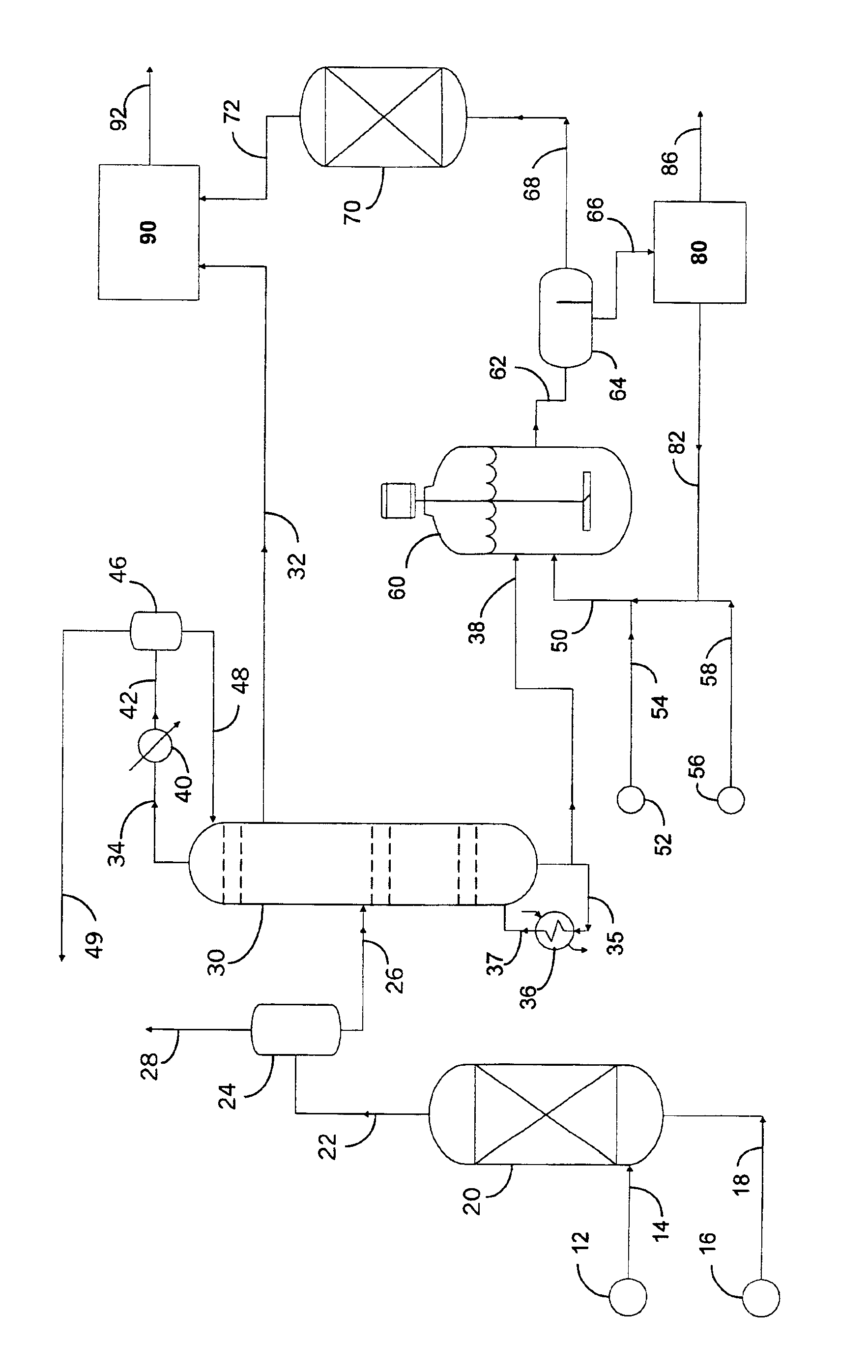Preparation of components for transportation fuels
a technology for transportation fuels and components, applied in the field of transportation fuels, can solve the problems of reducing the economic benefits of transportation, and reducing the environmental pollution of containing organic compounds in fuels
- Summary
- Abstract
- Description
- Claims
- Application Information
AI Technical Summary
Benefits of technology
Problems solved by technology
Method used
Image
Examples
example 1
[0098]In this example a refinery distillate containing sulfur at a level of about 500 ppm was hydrotreated under conditions suitable to produce hydrodesulfurized distillate containing sulfur at a level of about 130 ppm, which was identified as hydrotreated distillate 150. Hydrotreated distillate 150 was cut by distillation into four fractions which were collected at temperatures according to the following schedule.
[0099]
FractionTemperatures, ° C.1Below 2602260 to 2883288 to 3164Above 316
[0100]Analysis of hydrotreated distillate 150 over this range of distillation cut points is shown in Table I. In accordance with this invention a fraction collected below a temperature in the range from about 260° C. to about 300° C. splits hydrotreated distillate 150 into a sulfur-lean, monoaromatic-rich fraction and a sulfur-rich, monoaromatic-lean fraction.
[0101]
TABLE IANALYSIS OF DISTILLATION FRACTIONSOF HYDROTREATED DISTILLATE 150Fraction NumberItem1234TotalWeight, %45211916100Sulfur, ppm11.7251...
example 2
[0102]In this example a refinery distillate containing sulfur at a level of about 500 ppm was hydrotreated under conditions suitable to produce a hydrodesulfurized distillate containing sulfur at a level of about 15 ppm, which was identified as hydrotreated distillate 15.
[0103]Analysis of hydrotreated distillate 15 over the range of distillation cut points is shown in Table II. In accordance with this invention a fraction collected below a temperature in the range from about 260° C. to about 300° C. splits hydrotreated distillate 15 into a sulfur-lean, monoaromatic-rich fraction and a sulfur-rich, monoaromatic-lean fraction.
[0104]
TABLE IIANALYSIS OF DISTILLATION FRACTIONSOF HYDROTREATED DISTILLATE 15Fraction NumberItem1234TotalWeight, %53162011100Sulfur, ppm12138012.3Mono-Ar, %35.820.914.812.05.6Di-Ar, %1.38.07.45.64.0Tri-Ar, %0001.40.2Mono-Ar is mono-aromatics. Di-Ar is di-aromatics. Tri-Ar is tri-aromatics.
example 3
[0105]Hydrotreated refinery distillate S-25 was partitioned by distillation to provide feedstock for oxidation in a liquid reaction mixture with a soluble quaternary ammonium salt and an immiscible aqueous phase comprising a source of hydrogen peroxide and a phospho-metallic acid. Analyses of S-25 determined a sulfur content of 24 ppm, a nitrogen content of 16 ppm. The fraction collected below temperatures of about 288° C. was 70 percent of S-25. This sulfur-lean, monoaromatic-rich fraction was identified as S-25-IBP-288C. The fraction collected above temperatures of about 288° C. was 30 percent of S-25. This sulfur-rich, monoaromatic-poor fraction was identified as S-25-288C-FBP. Analyses of S-25-288C-FBP determined a sulfur content of 48 ppm, a nitrogen content of 49 ppm.
[0106]A nitrogen purged glass reactor fitted with a reflux condenser, overhead stirrer and thermocouple well was charged with S-25-288C-FBP (251.2 g), aqueous hydrogen peroxide (61.6 g of 26.0 percent by weight), ...
PUM
| Property | Measurement | Unit |
|---|---|---|
| dielectric constant | aaaaa | aaaaa |
| temperatures | aaaaa | aaaaa |
| weight percent | aaaaa | aaaaa |
Abstract
Description
Claims
Application Information
 Login to View More
Login to View More - R&D
- Intellectual Property
- Life Sciences
- Materials
- Tech Scout
- Unparalleled Data Quality
- Higher Quality Content
- 60% Fewer Hallucinations
Browse by: Latest US Patents, China's latest patents, Technical Efficacy Thesaurus, Application Domain, Technology Topic, Popular Technical Reports.
© 2025 PatSnap. All rights reserved.Legal|Privacy policy|Modern Slavery Act Transparency Statement|Sitemap|About US| Contact US: help@patsnap.com

